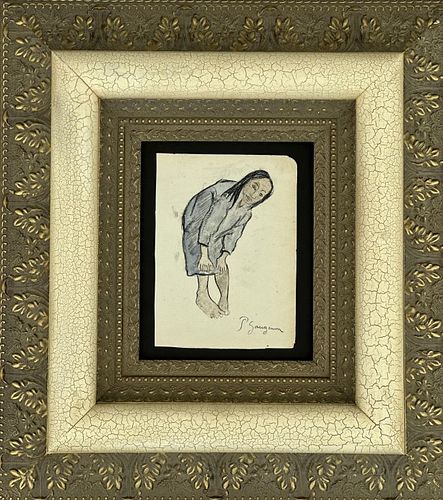PAUL GAUGUIN, Peasant Girl, Pastel & Charcoal on paper
Bid Increments
| Price | Bid Increment |
|---|---|
| $0 | $10 |
| $200 | $20 |
| $320 | $30 |
| $380 | $20 |
| $420 | $30 |
| $480 | $20 |
| $500 | $50 |
| $1,000 | $100 |
| $2,000 | $200 |
| $3,200 | $300 |
| $3,800 | $200 |
| $4,200 | $300 |
| $4,800 | $200 |
| $5,000 | $500 |
| $10,000 | $1,000 |
| $20,000 | $2,000 |
| $32,000 | $3,000 |
| $38,000 | $2,000 |
| $42,000 | $3,000 |
| $48,000 | $2,000 |
| $50,000 | $5,000 |
| $100,000 | $10,000 |
| $200,000 | $20,000 |
| $320,000 | $30,000 |
| $380,000 | $20,000 |
| $420,000 | $30,000 |
| $480,000 | $20,000 |
| $500,000 | $50,000 |
We were chosen to represent this exquisite little piece by a local art collector (87 years old) whose father had acquired the piece directly from the artist near the end of his life.So this piece has a family lineage dating back to the late 1800s.The piece measures 8 1/4 x 6 inches, and framed is 22 x 20 inches.Paul Gauguin was a highly skilled draughtsman and he left behind many hundreds of drawings by the time he passed away in the early 20th century. He was influenced by the Impressionists who also put a good deal of importance of this medium.Although his career was fairly varied, portraiture was always a significant part of his oeuvre. Gauguin loved to sketch local people in whichever region he was living at the time, be it provincial France or in some of the exotic destinations in which he spent time across his life. In some cases, when living in remote parts of the world, resources would become a major issue and normally there was an opportunity to draw even when perhaps oils or clay were in low supply. He also lived in some bright and warm locations, where the ability to sketch whilst outdoors would have been particularly appealing. He made use of pastels and also charcoal to produce different results within his work, and most of the drawings featured in this section were from the latter. His sketchpads were entirely portable and offered him the chance to be more mobile whilst working, rather than dragging a huge easel around with him.This was an artist who liked to produce intimate portraits, and drawing allowed him to work with little or no preparation. He could capture a scene instantly, whenever the whim took him, just as someone might today take a photograph of a memorable moment. You will see that in some of the drawings below of Emil, where he was perhaps wishing to record a moment in time and quickly stroked some charcoal across a small pad in order to do so. Although he experienced difficulties as a father, ultimately splitting away from his wife at one point in his life, he must have still had a love for his children which shows through within these drawings. In other examples he would capture local Tahitian women whilst living there and then later make use of these sketches for larger, bolder paintings. Drawing is an art form with multiple uses - one can produce independent artworks or alternatively plan later oil paintings or sculptures by laying out a rough composition on paper first.Gauguin also developed his own technique for transferring some of these drawings across into prints as a means to increase his earnings and spread his artistic reputation deeper into society. He was someone who liked to try out new ideas throughout his lifetime, and the excitement of living in different cultures further drove his enthuastic personality. Whilst not all of his ideas were successful, he carried on regardless and would later inspire a number of other Europeans to try out these niche mediums as well. Another by-product of his experiments would be the loss of some detail from his drawings once they had been transferred across into prints - this actually allowed him to produce a sort of abstract style that he appreciated, even if the effect had not been intended. Abstract art was a new theme during the early 20th century and also linked well with the Primivist style of Gauguin, where non-European artists had already been working in an abstract way for many centuries.The artist would draw throughout his lifetime, and we have a large number of items from the late 1880s in which he captured portraits of French women going about their daily lives. Later on there would also be a number of watercolours too, an art form which sits somewhere between drawing and oil painting. He did not receive the levels of artistic training that other famous names might have enjoyed, and so experimentation and practice were very important to his development. He also studied other forms of art in detail and would try out ideas from them from his sketchpad in order to quickly gauge an understanding of them. Monet would work with pastels frequently and that would have pricked his interest, even though the content found in their respective careers was not the same. He also was well acquainted with other great names of the time such as Degas and Pissarro, both of whom were also highly accomplished draughtsmen. He had a fractured relationship with some of these individuals, but never lost respect for the work that they were producing at the time.
Condition
Fair-Good, There are some smudges along the left side, and throughout the piece. The top right corner edge is rounded. It is framed in an ornate frame, (frame is 40 years old)
Available payment options

Bidder Can Make Shipping Arrangements, Local Pick-Up, In-House Shipping


